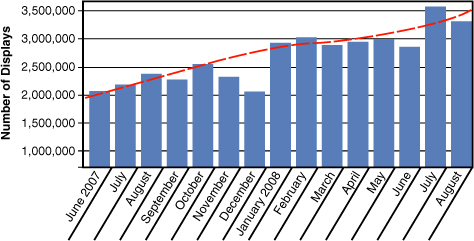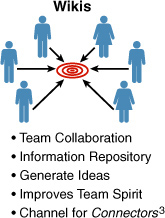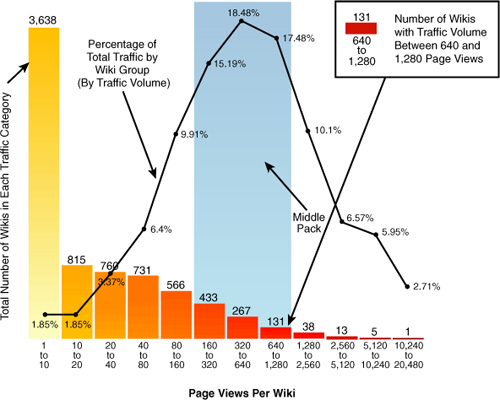After reviewing how we got here and seeing the restructuring necessary for your company to thrive in the Social Age, we can turn our focus to some of the tools that increase organizational transparency and efficiency.
Regardless of size, companies know that excellent communication is a competitive advantage. Conversely, poor communication can be painfully costly—in lost customers, high employee turnover, and decreased productivity. Much like Guttenberg’s printing press, the Social Age has created a worldwide communications revolution of historic proportions. Fueled by Web 2.0 technologies, social networking sites, wikis, and blogs, the Social Age is emerging everywhere, seemingly overnight.
The Social Age dawns just as profound changes are dramatically sweeping through the global economy, through society, and through technology. An increasingly complex and connected world calls for creative multidisciplinary approaches to solving novel challenges—traditional or conventional collaboration methods just won’t cut it anymore. Savvy enterprises must embrace the Social Age or be left in the dust by those who do.
These three factors—economic pressures, societal changes, and advances in technology—although seemingly unrelated to the current frenzy for wikis and blogs, have accelerated their acceptance and massive adoption, both inside and outside corporations. Companies are increasingly leveraging Social Age collaboration among their employees and with customers to accelerate innovation and enhance productivity.
Perhaps the most well-known example of Social Age wiki collaboration is Wikipedia, the ninth most-visited site on the Internet.[1] Wikipedia contributors from around the world collaborate continuously to create an extraordinary online encyclopedia. If you haven’t visited Wikipedia, perhaps you have friends or children who collaborate on a personal or business wiki.
Wikis—led most obviously by Wikipedia—have changed forever the way we communicate and gather information; and they are certainly not just another chat room or forum. The same technology that enabled two-way communication and collaboration in Wikipedia, using a free-form editing style, has enabled the creation of many other types of wikis. New wiki applications empower users to collaborate and build solutions together. With wikis, we can track action items, distribute work loads, and create an entirely new work experience. In many cases, wikis make face-to-face meetings obsolete. Regardless of location, employees can now use wikis to be part of a productive, enthusiastic, and supportive team.
Certainly some people continue to look with suspicion on wikis and other Social Age communication tools, but social changes and economic factors will drive increased adoption. Although some users might accept wikis and blogs more slowly, Millennials and mid-career professionals are responding enthusiastically and embracing them with a passion. They see wikis and blogs as career accelerators. They provide an easy way to make highly visible contributions through effective collaboration and communication.

Wikis and blogs are not just a new expression of the traditional “vanity press.” In many ways, wikis and blogs have instead become the ultimate expression of free speech. Wikis and blogs can also ensure that only the best ideas and writing emerges from the collaboration of experts in a particular discipline. Passionate, expert minds converging in a single space can produce amazing results. Finance, education, government, and technology are among the fields benefiting greatly from wikis and blogs. In fact, blogging has now hit the business mainstream and is quickly becoming a preferred method of corporate communication. We look at blogs in more detail in Chapter 4, “Blogs: Your Personal News Outlet.”
So what is a wiki? Is it an over-hyped fad that will fade just as quickly as it arrived? Well, perhaps like me you’re overloaded with e-mail and have a to-do list that never seems to get shorter. You know you need help, but you don’t know how to get help or how to ask for it. Until now you might not have realized it, but you need a wiki!
At IBM, we were pleasantly surprised a couple of years ago when we launched a wiki initiative, and within a year, more than 150,000 IBMers were contributing to internal wikis. That’s a powerful success story that we explore in detail later in this chapter. Let’s first consider a brief explanation of wikis and their place in the enterprise.
Wikis serve at least three functions inside the enterprise. First, some employees use wikis simply to create static Web sites to communicate with large communities. Using a wiki simplifies the content management and publishing processes. Wikis can also be configured to create private team spaces where a limited audience shares collateral, plans, and documents. Finally, as in the case of the well-known Wikipedia, wikis are used inside the enterprise for dynamically cataloging and defining historical facts and processes. A company wiki is surprisingly attractive to employees and a powerful way for employees to catalog their experiences.
In each case, a wiki is a powerful collaboration tool that brings teams together and simplifies communication, especially among geographically dispersed team members. Wikis also create tighter relationships within matrix organizations, lowering the degree of separation between individuals. Wikis create a level playing field in which team members have equal access to information and tools to contribute to the success of the business. In this way, wikis encourage transparency by democratizing business processes. Clear business strategy, intent, and direction are all important to employees. In this environment, the transparency provided by wikis becomes an obvious organizational strength.
And perhaps most importantly, wikis align nicely with the organizational trends in the enterprise we discussed in Chapter 2, “Social Age Organizations.” Rather than a hierarchical structure, the enterprise increasingly embraces a looser, more project-specific organizational structure. As we said, these new groups might still have a formal leader, but true leadership often rests with someone else within the group. The strength of these groups is seen in their capability to quickly form and disband based on business need and their ability to attract the best talent to accomplish a given task.
In addition to the benefits of wikis previously listed, they are also an excellent way to distribute skills and experiences within the wiki community. “Hard” technical skills—often learned in a classroom setting—and real-life experiences are fundamentally different competencies. Companies struggle with the best way to disseminate institutional, experiential knowledge—also known as “tacit knowledge”—to employees. Tacit knowledge is the insight gained by personal experience in the day-to-day difficulties and successes of the job. Such knowledge is often difficult to communicate in books or methodologies. Wikis help increase basic technical skills, but more importantly they increase the level of collaboration that serves to build and strengthen core competencies, including the crucial aspect of tacit knowledge. Although wiki collaboration is a nontraditional face-to-face activity, it still generates experiences that are the essence of tacit knowledge. The result is dramatic advances within the wiki community in knowledge sharing, collaboration, team-building, and trust. Essentially, wiki collaboration taps into the incredible power of shared experiences.
Active wikis can also improve technical skills in a team faster than traditional learning activities such as reading books or corporate training. This is especially true on development teams that follow Agile Methodology. In the knowledge-sharing context of a wiki, the skills of the team quickly accelerate to a point of parity. As a result, everyone contributes to the project at similar levels.
Efficiencies are obtained from factors already mentioned, but advances also occur when members sense the camaraderie and community nature of the wiki. This team spirit tends to cause the community to take ownership of problem resolution. Optimal wiki communities are marked by high levels of volunteerism to work on tasks. In this environment, project managers happily work with “volunteers,” rather than having to push work onto unwilling or reluctant employees with no sense of community.
Wikis also tend to promote more experimentation because wiki team members feel they are in a safe “cocoon.” Members know that if they get into trouble, the community will guide them. For example, a wiki member might be unfamiliar with a product enhancement or feature. Rather than attempting to solve the problem or search for an answer, the wiki member can query the community and quickly receive assistance. Similarly, wikis encourage the basic human instinct to seek safety in numbers. The collaborative tone of a wiki happens even when community members have never met each other face-to-face, work in different countries, and confront major time zones differences. It is often extraordinary to see that noncollocated groups that use a variety of social tools experience social bonding of the same intensity as traditional collocated teams.
Strong wiki communities encourage conversations that enrich understanding and provide value at the individual and at the group level. As any CEO will tell you, social interactions don’t pay the bills. The reason companies are embracing wikis is the noticeably improved work environment, productivity, and creativity of employees who use wikis, all of which can contribute to the bottom line.
To ensure a positive wiki experience for all, companies must define, establish, and enforce ethical conduct guidelines. Under no circumstances should hostile and aggressive interactions be tolerated on wikis or other social networking forums. A “bully” or a few disrespectful comments can damage or destroy the trust of the community. The safe and supportive wiki environment must be protected.
Collaboration is the most obvious value provided by wikis. However, wikis offer a secondary and perhaps equally important advantage: They generate a wealth of data that can be mined to support other projects and business initiatives. But proceed cautiously. Before engaging in any wiki data mining, employee personal privacy must be carefully protected. Thoroughly document the governance model that maintains the privacy of employees and communities involved in the wiki process. This is a key best practice to preserve the trust of the wiki community. If the company IT team is perceived as a watchdog, intruding on people’s privacy in any way, the trust of the community will be broken. Trust takes some time to build, but it is the bond that maintains a thriving wiki community.
The wiki community should always view the IT team as an enabler and facilitator, alleviating pain points and providing an effective platform for communication.
Businesses must respect and comply with privacy mandates that maintain wiki community trust but can still draw great benefit from wiki mining. Respect for employees’ privacy and data mining are not necessarily mutually exclusive. But be careful. A few misguided steps from the IT group can easily jeopardize this hard-won trust with devastating consequences to the productivity of a team.
Wiki data can be mined to identify trends and ideas within the business to predict future demand and products. Because wikis are inherently open environments, the wiki communities create a transparency that can reveal the true leaders—not just of a project, but those leaders who have the know-how and are eager to help transform the company into a true—and effective—meritocracy.
As we discussed, overwhelming anecdotal evidence points to the effectiveness of Social Age tools like wikis and blogs. And now data gathered within IBM from 2006 to 2008 provides substantial empirical evidence about the transformative power of these tools. The data is provided courtesy of IBM and offers compelling insights into the ways Web 2.0 tools have supercharged innovation and productivity at IBM.

IBM started an innovation project in 2006 with the modest goal of increasing communication channels, improving collaboration, and reducing overall e-mail traffic. Other objectives included increased employee productivity and improved documentation quality for some key projects—specifically to facilitate auditing and root cause analysis. The original success criterion of the project was to have 20 percent of technical employees participate in the new wiki and blog services. By mid-year 2006, the IBM wiki and blog services had been deployed to a subset of early adopters. These new wiki and blog services were called WikiCentral and BlogCentral. Following enthusiastic initial feedback, a full deployment plan was implemented in 2007.
Remarkably, WikiCentral took nearly everyone by surprise as it quickly surpassed 150,000 users in daily volume across all wikis in just one year. Total page views per month (Figure 3.1) reflect this massive adoption. This participation rate, which represented approximately 40 percent of the total workforce, was startling to say the least, and happily far surpassed our most optimistic predictions. These were people who might or might not have collaborated before, but within a year more than 150,000 of them were working together using a wiki.
Figure 3.1. Monthly volume of displayed pages reflecting IBM wiki traffic from June 2007 to August 2008.

These results provided initial evidence that wikis are for real and potentially represent one of the most important productivity tools in the history of IBM. Traffic volume on IBM wikis nearly doubled in July 2008 when compared with July 2007 (Figure 3.2). Overall, network traffic (representing unique visitors) on WikiCentral increased by more than 40 percent. Because WikiCentral was intended specifically for business-related collaboration, traffic was uniformly lower on weekends in both 2007 and 2008, as illustrated in Figure 3.2. The slightly increased volume on Sunday was caused primarily by countries such as Israel, which traditionally works on Sundays.
When the data at IBM was dissected, it was found that wikis established for project collaboration do not all attract the same level of activity. A strong “middle pack” of wikis generated more than 50 percent of total wiki traffic at IBM (see Figure 3.3 for wiki activity in 2008).
For example, these middle-pack wikis included 433 wikis that generated between 160 and 320 page views each in 2008 (see Figure 3.3, left-most middle-pack bar). This data point illustrates a tremendous collaborative effort around scores of projects, each of which generated value to the business. When taken in combination with the other data represented by this graph, it is easy to see the advantages of this social networking medium.
But that’s all just data, isn’t it? To actually get a sense of the “buzz” around the wiki phenomenon at IBM, and a sense of the power unleashed by a wiki, a quick trip to WikiCentral is all it takes. At random, I opened one of the top ten wikis on WikiCentral and found that more than 100 IBMers are registered users of that wiki, across an organization with more than 21 departments.
The “Function Zone” page of the wiki, “…[can be] modified by anyone with knowledge to add or amend.” More than 50 topics are currently discussed in the Function Zone, from “Best Practices” to “National Language Support” to “Versioning.” This wiki supports an IBM business unit that is global in scope and meeting the needs of literally thousands of customers. And yet despite the incredible size and breadth of this business unit, customers receive products, services, and support more efficiently than ever before, thanks to this wiki.
The 100+ IBMers updating this wiki represent only a small percentage of those who benefit from it. There are certainly many others who access the knowledge and experience contained on the wiki and yet don’t necessarily contribute. Keep in mind that our data showed that within a year of the first wiki being established on WikiCentral, more than 150,000 IBMers were creating, accessing, or updating wikis.
For those who doubt the incredible power of a well-executed wiki strategy, all we can say is, “Can 150,000 IBMers be wrong?”
As I write this, IBM has just published its quarterly results,[2] that not only exceeded analysts’ expectations, but which also included an optimistic outlook for the current year. These results come in the midst of a worldwide economic slowdown and deep recession that some are comparing with the Great Depression. Is there a correlation between the success of IBM and the social tools now used extensively by IBMers? As we said at the beginning of Chapter 1, “Dawn of the Social Age,” only time will tell. However, at least for now, social tools enjoy great traction across businesses and the trend will continue. Remember, communication and collaboration are vital for business success, and social networking makes it happen!
Wikis are powerful tools that facilitate engaged and productive teams, and serve as a strong complement to content management systems and blogging tools. Wikis enable rapid, lightweight content management and collaborative authoring, and, as with most social networking tools, wikis require little technical knowledge.
Commercial wiki offerings include hosted offerings such as Socialtext and Wetpaint. These are among the wiki-farms that allow wikis to be hosted by a single provider. Atlassian’s Confluence is among the services that deliver similar capabilities and ship with a commercial open source license. (We explore open source in detail in Chapter 8, “On the Shoulders of Giants.”) Other open source wiki solutions include MediaWiki, TWiki, DokuWiki, and PmWiki. Each of these offerings has a different focus, so be sure to review technical and functional requirements prior to adoption. Also, hosting your wikis with a third-party provider can save some cost, so be sure to consider this aspect as well.
As with other social tools, wikis didn’t just appear one day. Several iterations of earlier technologies eventually evolved into what we know today as wikis. Perhaps the most venerable of these earlier social networking tools are online forums and mailing lists. Although somewhat “last millennium,” these tools still have a place to enable grassroots collaboration. Forums enable orderly, web-based discussions on specific topics. Most forum software can be configured with e-mail notification to keep members informed of forum activity.
LISTSERV-type software uses e-mail for member discussions rather than a web browser. Subscription and preferences allow a user to configure levels of involvement. If a LISTSERV is particularly popular, a user might elect to receive the digest of discussion rather than a flood of e-mail for every thread update. Although somewhat “old school” in the world of social networking, forums and LISTSERV provided the foundation for many wiki and blog technologies.
Perhaps because of their maturity, forums and mailing lists tend to be built on open source software. Commercial offerings in the forum space include vbulletin, Clearspace, and Simple Machines Forum. Open source alternatives include phpBB, Vanilla, Yet Another Forum, and JavaBB. Look for web-based discussion forums that include simple user experiences, easy file attachment, and straightforward ability to register for notification of threads of interest. Forums offer a fast, user-friendly, and cost-effective way for employees to share insights and successes and to quickly find answers to difficult challenges.
Mailing list solutions, like many forums, are usually open source or free. An exception is LISTSERV, perhaps the best-known commercial offering. (Despite LISTSERV’s trademark, “listserv” is often used as a generic term for mail list discussion systems.) Majordomo, GNU Mailman, and Sympa are among the most popular open source mailing list solutions. For an easy-to-deploy start in social networking, an open source mailing list can be ideal.
If dialogue is the core of collaboration, file sharing offers a powerful complement. Discussions around shared documents add to the efficiency and productivity of the creative process. As social networking evolves inside your enterprise, be sure multiple tools aren’t enabling similar function. For example, decide if you want files stored with wikis, forums, or some other shared tool. Some commercial solutions unify assets into a common digital library—a master repository—to which all other tools point.
Commercial file sharing solutions are either hosted offerings or customer-deployed. Solutions such as Xdrive, box.net, and ADrive are all popular hosted solutions. For a recurring cost, files are stored securely online and made available to a specific audience.
File folder sharing is also available through many operating systems at no cost, and products such as FolderMaestro and Lotus® Quickr™ offer shared digital libraries as part of workgroup enablement. WebDAV (Web-based Distributed Authoring and Versioning) is a widely used web technology, and an internal WebDAV essentially offers a “shared folder” where employees can share files.
Open source file-sharing options include PHPFileNavigator, Boxroom, and Mindquarry. These offerings enable scalable solutions but without the costs of commercial software. Keep in mind, however, that enabling a true digital library for an enterprise requires a commitment of time and resources, regardless of the technology.
If your business is comfortable using a hosted solution for sharing documents, this might be the simplest online approach. Alternatively, shared folders are often suitable for small businesses. For medium and large businesses, other options should be reviewed. Every solution offers a different set of features, and as with other social networking technology, user content and contributions create the inherent value of the solution.
The heart of any business is the knowledge and experience each employee contributes to the common goal of profitability. As we’ve experienced first-hand at IBM, and as we’ve sought to communicate here, wikis are perhaps the best vehicle for unlocking this tremendous potential. They bring together teams of people who contribute relevant skills and experiences to a particular project, and in the process, those skills and experiences are effectively communicated to others on the team. With wikis, the “college of practical knowledge” is always in session, for the benefit of your employees, and for the success of your organization.
In Chapter 4, we explore blogs, a Social Age communication tool that is perhaps even more popular than wikis, and that can also have significant impact on both the profitability and efficiency of your business.
• Several factors, including societal changes, economic pressures, and increasing complexity, have rapidly accelerated the acceptance and massive adoption of blogs, wikis, and other Social Age tools.
• Wikis are powerful collaborative tools that “pull” information to facilitate communication within communities of contributors. Wikis provide additional value by being a rich data mine for the business to anticipate future demand and new products.

[3]
• Wikis provide a unique and incredibly powerful way to access, disseminate, and preserve the tacit (experiential) knowledge now locked away in the minds of your employees.
• Wikis follow a unique behavioral pattern. The “middle-pack” wikis generate more than 50 percent of the total traffic. These middle-pack wikis represent the volume generated by collaborating teams constantly updating their wikis.
• Wikis can be augmented with more mature tools such as forums and mail lists to round out collaborative social networking offerings in your organization.


